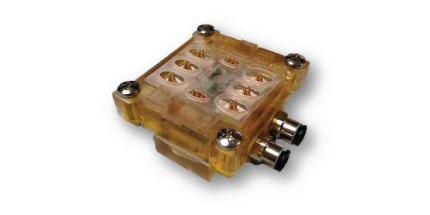Semiconductor
SEMICONDUCTORS
Advancing talent and research for the chip industry
Meeting the nation's semiconductor talent shortage.
As companies around the world launch plans to onshore semiconductor chip production, a new challenge is quickly being revealed—a national shortage of labor skilled in semiconductor technology.
Virginia Tech is stepping up to fill the talent and research pipeline by preparing students through a pioneering new Chips-Scale Integration program, infusing industry-inspired learning in the classroom and propelling use-inspired research.
PERSPECTIVES
“The Chips Act has sparked excitement about the US and its’ attractiveness as the next major investment region for the global semiconductor industry. Throughout the entire industry ecosystem, firms are making strategic decisions about where and how to expand their operations. While the nation is watching where the large fabs will land, we should remember that there are many other critical players in the industry value chain that will also in parallel be evaluating where to locate their own operations. In my 30 years in the industry, I can attest to the critical role access to talent and research partners will play in that decision making process. With a legacy of excellence and a nationally-ranked ECE program, Virginia Tech should be a go-to partner for companies moving forward."

Kevin Crofton '85, Board Member and Chairman, Executive Committee, SEMI

IMPACT
Bradley Department of Electrical and Computer Engineering (ECE) Playbook
Virginia Tech’s top-ranked computer engineering program is known for providing hands-on opportunities for students via internships, a legacy of world-class research and its team-based, multidisciplinary approach. ECE stands as the largest program in Virginia Tech’s College of Engineering.
#4
in the U.S. for producing most undergrads in computer engineering
top-10
research enterprise with over $60M/year in expenditures
120+
ECE interdisciplinary faculty and researchers
30
IEEE fellows, 22 NSF Career Awardees, 4 DOD YIP Awardees - ECE faculty
top-10
institution for undergrad degrees awarded to women in engineering
~ 450
ECE degrees conferred annually
FOCUS
Chips-Integration Degree: our strengths match the rapidly evolving needs of the semiconductor community.
The Chips-Scale Integration major caters to students who are seeking to harness advances in integrated digital and analog electronics to add greater functionality, improve performance, minimize power consumption, and expand applications. Students in this transformative program are collaborating across disciplines while learning from faculty and industry experts in manufacturing, chip design, packaging and power, and graduate ready to apply domain expertise in the highly complex field of systems design and integration and everything in between.
To the semiconductor industry, we offer a compelling value proposition that includes:
- a pioneering new Chips major for top talent,
- expanding professional masters degrees,
- robust doctoral programs to advance the bleeding edge of research and innovation, and
- a legacy of research with industry
- Addition of a senior design course – the Major Design Experience (MDE) – gives seniors a taste of the engineering profession. Students work together in teams and tackle real-world problems for customers like Lockheed Martin, Texas Instruments, BAE Systems, GM, and many others.
RESEARCH
Fusing research and education for futures of tomorrow.
From integrated circuits, to packaging and design, selected research and faculty highlight the depth and breadth of ECE.
Faculty: Christina DiMarino (ECE), GQ Lu (ECE/MSE), Khai Ngo (ECE)
Expertise: Packaging for revolutionary advances in power electronics used in electric vehicles, aerospace, the electric grid, and defense
systems.
Features: New packaging technologies, materials, and integration strategies are essential to extracting the benefits of advanced
semiconductor devices (e.g., WBG)
Key Challenges:
- Electromagnetic compatibility for highspeed
devices and high-density-integration - Harsh environment operation and reliability
for defense and transportation systems - Material-device-packaging-circuit co-design


Faculty: Masoud Agah and Leyla Nazhandal (ECE)
Expertise: Field Portable and Wearable MEMS-enabled systems.
Applications:
- Environmental monitoring
- Disease diagnostics
- Monitoring substance adulteration
- Homeland security
- Quality Control
Key Challenges:
- Uniform functionalization of sensors
- Compact integration of fluidic and electronic components
- Minimal chip-to-chip variation

Faculty: Jeff Walling (ECE)
Expertise: Wideband, adaptive, linear and energy-efficient integrated circuits from mm-Wave to THz
Key Opportunities:
- Machine Learning/AI-based RFIC/mm-wave IC optimization
- Increase information rate, spectral- and energy-efficiency
Key Challenges:
- Low device gain, high passive losses
- High-speed, high bandwidth mixed-signal interfaces
- Coordination across large-scale arrays
Fully digital mm-Wave transmitter from VLSI 2021. Machine learning adaptation will provide opportunities to scale frequency, bandwidth and linearity.


Faculty: Paul Ampadu (ECE) and Leyla Nazhandali (ECE)
Expertise: Lightweight and low-power ICs. Secure and Resilient Network-on-Chip and System-on-Chip. Fault-attack resistant microprocessors.
Key Challenges:
- Energy-efficient yet function-complete Hardware
- Fast response times under HW complexity
- Hardware/Software Co-design
Secure-Resilient AI Chips: Key Challenges
- Identifying common AI primitives
- Narrowing prevalent AI applications
- Algorithms simplification for HW designs
- Effecting jointly secure-resilient AI chips
Other
- Internet-of-Things (IoT) chip
- 5G chip with J. Walling of ECE
- Hardware for Energy Systems security


Faculty: Yang (Cindy) Yi (ECE)
Expertise: Design and optimization of AI chips for real-time data analysis, time-series predictions, and dynamic control
Features:
- Scalable, robust, and energy-efficient 3D neuromorphic computing
Key Challenges:
- Energy efficient spiking neural network
- Robustness and scalability
- System prototype and emerging applications in cognitive computing and quantum computing


Faculty: Dong Ha (ECE)
Expertise: Integrated circuits capable of operating at high temperatures.
Applications:
- Extreme environment sensing
- Oil and gas exploration
- Car/jet engine monitoring
- Spacecraft
- Elimination of heat sinks+ Oil and gas exploration
- Car/jet engine monitoring
- Spacecraft
- Elimination of heat sinks
Key Challenges:
- Fabrication of devices (such as SOI) to operate temperatures above 600 °C.
- Develop packages to operate at high temperatures.
- High temperature circuit design


Faculty: Yuhao Zhang and Mantu Hudait (ECE)
Expertise: Power devices and ICs for revolutionary advances in power electronics used in electric vehicles, data centers, the electric grid, and
defense systems.
Features: New semiconductors, e.g., integrated group III-V and group IV, wide-bandgap and ultrawide bandgap materials, drive the power device
and IC innovations.
Key Challenges:
- Emerging power device & IC design, fabrication and characterization, with new semiconductors such as gallium oxide
- Power circuit design, development and manufacturing
- Introducing new semiconductors into silicon processing
- Machine-learning assisted material-device packaging-circuit co-design and semiconductor manufacturing.


Faculty: Linbo Shao (ECE)
Expertise: Integrated electro-optic and acousto-optic circuits on thin-film lithium niobate, quantum interconnects
Features: New semiconductors, e.g., integrated group III-V and group IV, wide-bandgap and ultrawide bandgap materials, drive the power device
and IC innovations.
Key Opportunities:
- High performance electro-optic devices e.g. modulator f > 100GHz, Vπ < 1V.
- Integrated hybrid circuits combining microwave, acoustic, and optical devices.
- Quantum information processing on silicon substrate
Key Challenges:
- Design, simulation, and testing of emerging microwave photonic devices
- Nanofabrication integration –multiple types of devices; lasers and photodetectors on chip
- Optical and microwave co-packaging


Signature center within ECE:
Center for Power Electronics Systems (CPES)
For the last 40 years, the CPES has partnered with industry and government to radically transform the electronics that are used to power everything from cell phones to electric cars to datacenters. CPES contributions have resulted in technologies that are incorporated in virtually every device including voltage regulators in microprocessors that are in high-end graphics processors, memory devices, telecommunication networks, and all forms of mobile electronics.
With a degree CPE and a major in Chip-Scale Integration, graduates bring depth and and a holistic view of other technical domains to become “T-shaped” professionals.


PARTNER
Meet your objectives while taking advantage of Virginia Tech’s truly one-of-a-kind features, including location, portfolio, infrastructure, mission.









John Ralston
Associate Director of Business Development, LINK, the Center for Advancing Partnerships
Let's connect today.
Every day, our faculty work to meet the pressing needs of the semiconductor industry by developing their future workforce and advancing interdisciplinary research, technology and policy. Together, with our partners, we are changing the world.
Virginia Tech offers a full range of ways to engage. Let's build a comprehensive relationship that helps your company meet its strategic goals.


